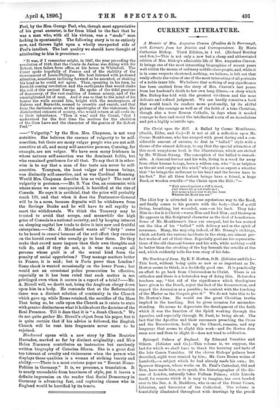The Christ upon the Hill. A Ballad by Cosmo Monkhouse.
(Smith, Elder, and Co.)—It is not at all a reflection upon Mr. Cosmo Monkhouse, who has essayed with great daring and a con- siderable amount of success, to deal in " ballad" style with a theme of the utmost delicacy, to say that the special attraction of this most sumptuous book is the illustrations, which are etched by Mr. William Strang. The conception of the ballad is remark- able. A charcoal-burner and his wife, living in a wood far away from other human beings, have a witless son, who "is as helpless as the air and empty as the wind," who yet is so expert a whistler that " he brings the redbreast to his haul and the brown hare to his feet." But all three forlorn beings have a friend, a huge Rood, or wooden crucifix—" the Christ upon the Hill :"— " High reared against a cliff it stood, Just where the gi eat roads met ; And many a knee had worn the .tone Wherein the Rood was set."
The idiot boy is attracted in some mysterious way to the Rood, and finally comes to his parents with the body—that of a still living, breathing, but wounded, man—on his back. They take Him in—for it is Christ—warm Him and feed Him ; and thereupon He appears in His Scriptural character as the God of beneficence. Some of Mr. Monkhouse's lines are unequal, but he has worked out the idea of his " ballad " with delicacy and in the spirit of reverence. Many, the majority indeed, of Mr. Strang's etchings, which set forth the various incidents in the story, are almost per- fect works of art of their class. Especially good are his representa- tions of the old charcoal-burner and his wife, while nothing could be better than the crushing of the boy beneath the crucifix at the end, which evidently tells the true story of his fate.


































 Previous page
Previous page